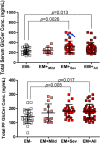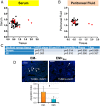Dysregulated sphingolipid metabolism in endometriosis
- PMID: 24960545
- PMCID: PMC5393497
- DOI: 10.1210/jc.2014-1340
Dysregulated sphingolipid metabolism in endometriosis
Abstract
Background: In endometriosis, the establishment and subsistence of ectopic lesions outside the endometrium suggest an altered cellular state for pathological hyperplasia. Sphingolipids are bioactive compounds, and their biosynthesis and metabolism modulate a range of cellular processes including proliferation, migration and apoptosis. We demonstrate that aberrations in sphingolipid metabolism occur in women with endometriosis.
Methods: Targeted mass spectrometry on >120 sphingolipids were measured in the sera (n = 62), peritoneal fluid (n = 63), and endometrial tissue (n = 14) of women with and without endometriosis. Quantitative RT-PCR and immunohistochemistry were performed on endometrial tissues determine the expression levels of sphingolipid enzymes.
Results: Sphingolipidomics identified the in vivo accumulation of numerous sphingolipids, including the functionally antagonistic glucosylceramides and ceramides in the serum and PF of women with endometriosis. We found upregulation of specific sphingolipid enzymes, namely sphingomyelin synthase 1 (SMS1), sphingomyelinase 3 (SMPD3), and glucosylceramide synthase (GCS) in the endometrium of endometriotic women with corresponding increased GlcCer, decreased sphingomyelin levels, and decreased apoptosis in the endometrium.
Conclusions: Our sphingolipidomics approach provided evidence of altered sphingolipid metabolism flux in serum, peritoneal fluid, and endometrial tissue in women with endometriosis. The results provide new information on how sphingolipids and eutopic endometrium may contribute to the pathophysiology of endometriosis. The results also have implications for the use of sphingolipids as potential biomarkers.
Figures




References
-
- Practice Committee of the American Society for Reproductive Medicine. Endometriosis and infertility. Fertil Steril. 2004;81:1441–1446. - PubMed
-
- Stefansson H, Geirsson RT, Steinthorsdottir V, et al. . Genetic factors contribute to the risk of developing endometriosis. Hum Reprod. 2002;17:555–559. - PubMed
-
- Zondervan KT, Cardon LR, Kennedy SH. The genetic basis of endometriosis. Curr Opin Obstet Gynecol. 2001;13:309–314. - PubMed
-
- Siedentopf F, Tariverdian N, Rücke M, Kentenich H, Arck PC. Immune status, psychosocial distress and reduced quality of life in infertile patients with endometriosis. Am J Reprod Immunol. 2008;60:449–461. - PubMed
Publication types
MeSH terms
Substances
LinkOut - more resources
Full Text Sources
Other Literature Sources
Medical

